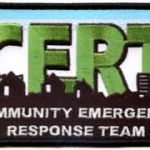
My wife and I participated in CERT (Community Emergency Response Team) training as a way to be official aides in our community in an emergency. Our city doesn’t have CERT but the county our church is in, sponsors one, so we signed up and trained there.
Here is brief synopsis taken from the CERT homepage:
“The Community Emergency Response Team (CERT) Program educates people about disaster preparedness for hazards that may impact their area and trains them in basic disaster response skills, such as fire safety, light search and rescue, team organization, and disaster medical operations. Using the training learned in the classroom and during exercises, CERT members can assist others in their neighborhood or workplace following an event when professional responders are not immediately available to help. CERT members also are encouraged to support emergency response agencies by taking a more active role in emergency preparedness projects in their community.”
The CERT concept was started by the Los Angeles Fire Department in 1985 as a way for civilians to aid local first responders. You can read more about CERT history on the About Page
What Do You Learn In CERT?
Introduction
Unit 1: Disaster Preparedness
Unit 2: Fire Safety
Unit 3: Disaster Medical Operations—Part 1
Unit 4: Disaster Medical Operations—Part 2
Unit 5: Light Search and Rescue Operations
Unit 6: CERT Organization
Unit 7: Disaster Psychology
Unit 8: Terrorism and CERT
Unit 9: Course Review and Disaster Simulation
I’ll cover the things that I remember; this is NOT all inclusive of the material taught.
Unit 1 covered some basic emergency preparedness, including having enough food and water for your entire family (including pets) for a minimum of three days. They also assert that every family member should have a kit with their essential supplies. It was explained that there are 300 civilians for every 1 first responder. We were trained that if there was an emergency and the CERT team was activated, we are to take care of our families first, then report to where we were asked to go. The county Emergency Manager explained that the reason we make a kit and have food and water stored is because they and FEMA would set up a FEMA shelter, but that we did not want to be there.
Unit 2 covered basic firefighting. We went to a fire station and were shown how to use a fire extinguisher and a fire hose. The different types of fire were explained and we were shown how to extinguish them. We were also taught how to develop an emergency plan, and how to turn off water, gas and electricity.
Unit 3 and Unit 4 taught us how to triage and how to treat the most frequent types of injuries that are found in emergency situations; some of which are airway obstructions, bleeding and shock; how to apply splints, treat wounds and burns.
Unit 5 covered how to size up a situation to see if entering a building is safe, look for fallen wires, smell for gas leaks, look for smoke etc. We learned the difference between light, moderate and heavy damage and how to mark an exterior door with symbols indicating that the area has been entered, assessed, exited and whether there are victims inside along with any other pertinent information. We were shown how to build a “crib”, which uses a lever and incrementing blocks to take the weight off of a victim, as well as safe ways to pull a victim out and carry or drag them properly.
Unit 6 explained the organization of response teams; who a CERT member may report to and their jobs in the different teams.
Unit 7 Covered dealing with emotions that survivors may have and keeping responding teams emotional wellbeing intact.
Unit 8 explained the different types of terrorist weapons; nuclear, chemical, conventional explosive and biological. There were explanations on what to do if there is an event and what the CERT role will be.
Chapter 9 reviewed all information. The exercise might be different for each group but we went to a law enforcement training center that has a couple of mock buildings set up. We used everything we learned while going through the process of sizing up the scene and entering the building to look for hazards and victims. We also set up a triage and trauma area that the victims from the building were brought to for treatment.
As I have stated, different CERT groups may handle things differently. Your experience may be different. The county we were trained in obtained a grant from FEMA and supplied us all with a CERT bag full of supplies. They also have monthly training on various items. When there is an emergency, a call is sent to all CERT members, detailing what they need to do. CERT was activated when the 35W bridge collapsed. CERT was also activated to walk the caution tape when a Police Officer was murdered, keeping the general public behind the tape. The county also uses the CERT team for non-emergency events, such as standing watch at flood zones or at various posts during fundraising events.
I highly recommend CERT for multiple reasons. You will learn how to be a resource to your community in an emergency. It will teach you how to respond in many types of emergencies, such as weather, fire, trauma or terrorism.
Because I believe CERT is such a good idea, I have added a way for you to find CERT and other Citizen Corp groups in your area, to the right of the article. Just add your Zip Code and you’ll be shown a list of groups near you.
Please click here to vote for Prepared Christian as a top Prepper site!
If you liked this article please think about sharing it on the social media listed below, thanks!



